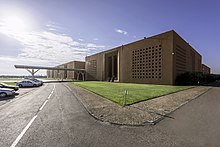|
Ricardo Bofill Taller de Arquitectura
Ricardo Bofill Taller de Arquitectura (RBTA) is an architecture firm that was founded in 1963 by Ricardo Bofill, initially as Taller de Arquitectura (lit. 'Architecture Workshop').[1][2] It is headquartered in Sant Just Desvern near Barcelona, in a former cement factory known as La Fábrica. History    Ricardo Bofill, then 23 years old, founded the Taller de Arquitectura in 1963 by with the encouragement and support of his father, the architect and builder Emilio Bofill. From the start, Bofill had the vision of a multidisciplinary team that would bring together architects, engineers, planners, sociologist, writers, movie makers and philosophers to generate original design ideas with a social and political purpose. Initial members of the team included Bofill's relatives and childhood friends such as Anna Bofill, Xavier Bagué and Ramón Collado; writer José Agustín Goytisolo; actress Serena Vergano; and visionary polymath Manuel Núñez Yanowsky, a former fellow activist of Bofill within the clandestine Unified Socialist Party of Catalonia. They were joined in 1966 by Peter Hodgkinson,[3]: 252 in 1971 by writer Salvador Clotas,[3]: 254 and in 1976 by architect Jean-Pierre Carniaux. At the very beginning, the Taller was hosted in the offices of Emilio Bofill's firm in the Banco de Vizcaya building on Plaça de Catalunya 5,[4]: 218 then moved to a temporary location on Calle de Calvet, then in 1965 to the new building designed by the Taller on Calle Nicaragua 99.[4]: 217 It moved to La Fábrica in 1975. From 1971 the Taller shifted its focus to France, and worked on prominent projects in state-sponsored new urban centers (villes nouvelles). In 1991, the Paris office moved into a purpose-built space at 18, rue d'Enghien, in the former seat of newspaper Le Petit Parisien;[5] it eventually closed in 2000. The Taller also maintained an office in New York City (on 394 West Broadway) from 1987 to the early 1990s, and other offshoots at various times in Montpellier, Tokyo, Chicago, and Beijing.[6] In the late 1970s, the Taller de Arquitectura collaborated with the Algerian government on urban planning and housing-related issues, culminating in the creation of an experimental new agricultural village at Méchraâ Houari Boumédienne near Abadla, Béchar Province.[7] Some of the Taller's architects have moved on to create significant architecture firms of their own, e.g. Manuel Núñez Yanowsky in 1978, Nabil Gholam in 1994, and Philippe Chiambaretta in 2000. Following Ricardo Bofill's passing away on 14 January 2022, RBTA is led by his two sons, Ricardo Emilio Bofill and Pablo Bofill.[8] Stylistic evolutionWith much simplification, the design style of RBTA can be described as having gone through four phases: the geometrical combinations of the early projects in the 1960s and early 1970s, inspired by Utopian socialism, vernacular architecture and critical regionalism;[4] from the late 1970s, a turn towards ostensibly classical forms associated with large-scale utilization of precast concrete; from the late 1980s to the 2000s, a gradual distillation of that classical inspiration into a more abstract vocabulary that still referred to formal geometries and increasingly used steel and glass as its prominent materials; and in the 2010s, a partial return to vernacular inspiration, particularly in projects in the Muslim world such as Mohammed VI Polytechnic University in Morocco.[9] As noted by Peter Hodgkinson in a video presenting the Taller's work in 1981, the group's building approach went from one extreme to the other in the space of two decades: from a strong emphasis on artisanal craftsmanship in the early 1960s, to large-scale heavy industrialization using precast concrete in the early 1980s. In the latter period, a division of labor existed between the two offices of Barcelona and Paris, with design functions centered in the former and industrialization and project execution in the latter, led at the time by Ramón Collado.[10] The pivot towards classicism has arguably been the most debated of these successive shifts. Critic Geoffrey Broadbent wrote in 1981 about RBTA's recent work: "The point, of course, is that having shocked people once [with the geometrical plays of the Taller's early period], if you want to keep shocking them, the most outrageous thing you can do, as an avant-garde artist, is to go back to the Classical!"[11] According to Peter Hodgkinson, the influence of Charles Jencks played a role in prompting the Taller's Classicist turn in the late 1970s.[4]: 241 In a noted study of France's evolving social structures and landscapes published in 2021,[12] political scientist Jérôme Fourquet and journalist Jean-Laurent Cassely wrote that "the monumental projects designed by Spanish architect Ricardo-Bofill in Noisy-le-Grand (Les Espaces d'Abraxas), in Saint-Quentin-en-Yvelines (Les Arcades du Lac) and in Montpellier (the Antigone neighborhood) are basically the architectural signature of the 1980s" in the country.[13] Selected projectsUrban design and landscaping
Transport and government infrastructure
Commercial
Offices
Culture and sports infrastructure
Housing
Selected exhibitions
References
|
||||||||||||
